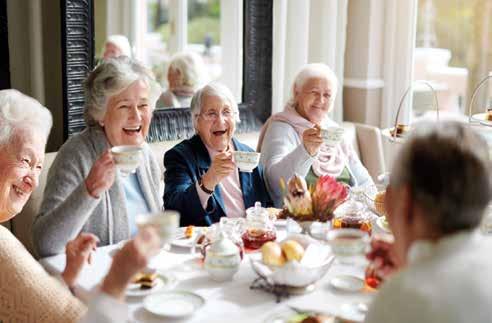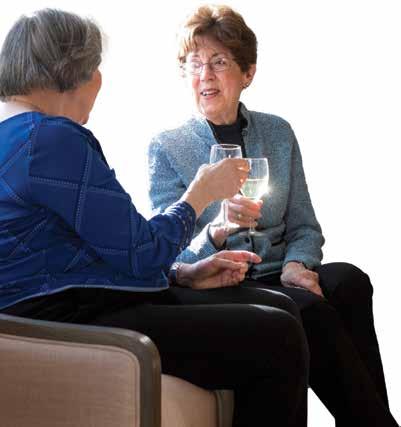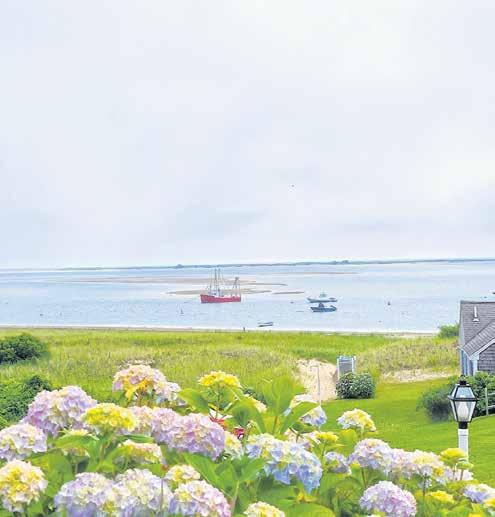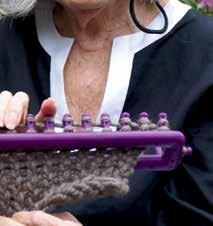
Love and Connection page 2
Solo Travel page 8
Artistic Reinvention page 12


Love and Connection page 2
Solo Travel page 8
Artistic Reinvention page 12
The idea of “aging unscripted” is about embracing the next chapter in all its forms — from finding different passions to forming new connections. Because it’s not about slowing down. It’s about stepping forward with purpose.
This section celebrates that very spirit: a dynamic exploration of love, relationships, and self at every stage of life. You’ll read about New Englanders who are traveling the world, pursuing artistic endeavors, and discovering new parts of themselves.
And for many, including the individuals featured in the photo essay below, it’s their relationships that help fuel the joy of living boldly and authentically. It’s those loyal friends and steadfast lovers who make it easy to live without limits on what’s next.

Judy Kennedy, 83, grew up in Minnesota. A Catholic nun for seven years, then married to a man for 25, her journey to true love was long and, at times, turbulent — until she met Deb Lowe, 80, at Cape Cod Hospital 30 years ago. Together, they’ve led a life of adventure, and they refuse to let anything stand in their way.
What’s the story of how you started dating?
Judy: “When I was a kid working in the bakery — because all us kids worked at our folks’ bakery — I was slicing hamburger buns and the song came on: ‘Old Cape Cod.’ And I said, ‘you know, someday I’m gonna go there.’ After I left my marriage, I was working at Holyoke Medical Center and this notice came across my desk that there was an opening at Cape Cod Hospital for a director of volunteers, and I applied and I got the job.”
Deb: “In ‘78 I went to Cape Cod
Hospital as an RN and started off in ICU. Then I became the Cape Cod Hospital Educator, and that meant setting up orientation for new employees. Judy shows [up], and that’s how we met. We were sitting and having coffee and somehow got around to the fact that she was married, but she was with some woman. Bingo. So we hung around a lot, and that’s when I gave her the ultimatum. I said, ‘I’m interested in really getting together. I’ll be [in my office] until 3 o’clock. If you’re interested, then come over and see me.’
So guess who showed up?”
What’s one of your favorite memories together?
Deb: “I think doing the Colorado [River] — that was six days and seven nights going down the Colorado River through the Grand Canyon. It was a motorized watercraft, but it was huge. Judy says, ‘sit up front with me!’ Well, I wasn’t prepared for that. It went up my nose, I lost my glasses and my hat, and I was not sitting up front again. They found my hat in the back of the boat three days later.”
Judy: “That’s where all the action is! I think another favorite memory, though, is Alaska. We did the Alaska train, we rafted a lot of the rivers, we did a fixed-wing plane, helicoptered onto a glacier, and we kayaked on Resurrection Bay — on the other side was a mother whale and her calf.”
What’s your secret to a happy relationship?
Judy: “I think our secret is acceptance of each other, of who we are. I know her as a person, so that doesn’t affect me in the sense that we have different points of view.”
Deb: “We don’t try to ask the other person to change for some reason. You know, if Judy wants to go out and do something or go to see some friends, I’m not upset or anything. I just adapt and do whatever I have to do.”


“I think our secret is acceptance of each other, of who we are. I know her as a person, so that doesn’t affect me in the sense that we have different points of view.”
− Judy Kennedy

Lucky in love

John Spanguolo, now 50, met Steve Morrison, now 71, in 2012 when Steve became one of John’s clients at his cleaning business. Although neither was expecting or looking for love, they immediately felt a connection. John made the first move, and today, they’re married, live in Andover, Mass., and couldn’t be happier.
Since 2012, how do you think your love has evolved?
John: “I feel like what we’ve gone through in 12 and a half years, most couples do in the span of 20. Unfortunately, we are at the age now where our parents do pass away, and siblings pass away as well.”
Steve: “But the reality of that is we are it. We really are here to support each other permanently, big time.
So if anything, we’re deeper and more close together. Unfortunately, we’re both from small families, and I now just have my brother left and a couple of cousins, but they’re not close by. So I remember [John] said to me, ‘you’re the closest family I have in this state.’”
What’s your secret to a happy relationship?
Steve: “If there’s a secret to it, it’s communication. We talk a lot. And John has always said, if there’s anything bothering either one of us, we need to bring it out into the open — and that was hard for me at the beginning. But he insists on bringing it out and resolving it. He’ll give me a little time to sit with it, but he can sense when something’s wrong.”

John: “For me, it’s communication and trust. And we don’t really ever have a dull moment. I think we really enjoy each other’s company. If you’re lucky enough to find somebody that you really care about and click with — because I do think it’s a little tough in the gay community. I think it’s tough anyway here, no matter whether you’re female, male, gay, straight, trans, to find that other person in life — hold onto them. I’m lucky.”
Any final thoughts?
Steve: “I got the better end of it; he just doesn’t know.” John: “Timing is everything in life.”

“I think it’s tough anyway here, no matter whether you’re female, male, gay, straight, trans, to find that other person in life — hold onto them.” − John Spanguolo

Retired nurse Pam Provisor, 73, met retired teacher Anthony Ferrante, 66, at the Cape Cod Historical Society in early 2021. Five years later these best friends look out for each other and have a bond that provides vibrancy, validation, and great company.
Did you imagine you’d have such a deep new friendship later in life?
Pam: “When we moved here full time, my husband and I frequently commented on the fact that one of the ways you obtained friends previously was through your children. Now the children are all grown; so now, how do you make friends? And I think in my mind, I had old friends from when I was younger and I have old friends from previous jobs. And I didn’t expect that there would be any more people entering into my friend’s circle. I wasn’t looking for it, and I wasn’t expecting it.”
Anthony: “All my friends were the friends I’ve had for 40 years, and even though they don’t live in Wellfleet, it’s still a really tight bond. But at my age, it’s hard to make friends. You’re so set in your ways at this point that you expect something from friends you already have. But making new friends? It’s cool.”
How does friendship bring you purpose and fulfillment?
Pam: “Well, my husband’s still alive, thank goodness, so I have him. But Anthony lives alone, and I have other friends that live by themselves, and I feel like we need
to keep in touch and watch out for each other. I’ll think, ‘Oh, what’s Anthony doing? I wonder if he’s been by himself for too long. Maybe I should check in and see if he wants to do something.’
It’s part of how to maintain connections, but also maybe having that support system will help us stay in our homes longer and stay mobile longer. So I guess it’s part of my long-term plan for health. But in addition to that, it’s also making sure that my friends that may not have partners nearby are okay too.”
What has volunteering together
at the theater taught you?
Anthony: “I work at the WHAT theater, and I also volunteer at the museum, so I’m busy, but I want to be busy, and I don’t want to be on payroll. I like volunteering. If I want to leave, I can just leave. I just want to be free as a bird, and the volunteering thing is working out really well.”
Pam: “Grammy is not just Grammy who comes and brings you presents. Grammy has a life. And I think when you get older, people forget that, and they don’t see you for all of your accomplishments any longer. You’re just a retired person with no expectations. You know, ‘I’ll live to see my grandchildren and so be it. I’ll walk on the beach by myself because I’m old now’ — but it’s not like that. It doesn’t have to be like that.” ■




























The freedom of solo travel fosters empowerment, adventure, and camaraderie for active adults.
BY ANNIE SHERMAN
Sitting in a terrace restaurant atop Mount Igueldo overlooking San Sebastián, Spain, Karina Holyoak Wood felt a mix of enchantment and empowerment. The 56-yearold Providence, R.I., resident and UK native had scheduled her extensive itinerary and traveled to Europe alone, navigated the Basque city’s 181-meter slope and found her inn after check-in hours, and finally settled into a dinner table with a renewed sense of confidence knowing she was in charge of her adventure.
“What I love about traveling by myself is that it feels like I’m the protagonist in a story, in a way that I don’t feel when I’m with someone,” says Holyoak Wood, executive director of Goldman Sachs 10,000 Small Businesses RI, and a divorcée with two grown daughters. “When you’re with a group or your family, it’s a different kind of fun. When I’m in an amazing setting by myself, I think, ‘Where does this hero go next?’”
Active adults 55 and older are embracing this type of independent travel, proving that age is no barrier to exploring the world. It’s an opportunity for them to embrace the freedom of reconnecting with their own pure interests, while enjoying the camaraderie of a congenial community.
This approach to travel is evident across the industry, with a rise in solo bookings among active adults year over year. The educational travel company, Road Scholar, reported that 20-30 percent of its nearly 100,000 annual travelers choose to go by themselves, and many are 65 and older. In AARP’s 2023 Travel Trends Report, 12 percent of international trips among those ages 50plus were solo. Meanwhile, women
travelers increasingly embrace solo trips with intention and purpose, particularly to explore new and less-traveled destinations, reports a JourneyWoman study.
“I’ve had a lot of 55-plus solo clients this year, and that seems to be the theme,” says AAA travel advisor Wendy Marley in Newton, Mass.
“People are finally past the restrictions of COVID, and now they’re thinking, ‘maybe I can see Europe.’
Some of them that were traveling already are now saying, ‘maybe I can visit Thailand or Vietnam.”
Nadine Paulo, founding owner of The Solo Travel Collection in Westport, Mass., explains that whether they explore the Aegean Sea or discover a Portuguese market, bungee jump in New Zealand or investigate their family lineage in Scotland, travelers in New England aren’t waiting for a wingman to explore
Active adults 55 and older are embracing this type of independent travel, proving that age is no barrier to exploring the world.
the world, and they’re not afraid to be alone while doing it.
“They not only travel to restore and explore their surroundings, but they’re traveling to feel empowered,” Paulo says. “People want to connect, whether that’s with themselves, and they want to revisit who they are, or they want to connect with other individuals, to find a new community or new friendships. They also want to connect with and understand the world from a different perspective.”
Forging connections through solo travel
To do this, Wood has traveled with tour groups, close friends, and visited family in 15 countries around the globe. But when she chooses to travel alone, it’s not because she wants to actually be alone. The self-professed people-person rarely ever finds herself without something to








do, see, or eat without a companion. While she enjoys reading a book in a cafe or doing a solitary hike, she says she’s more likely to sit at the bar for dinner and strike up a conversation with her neighbor than hide in her hotel with room service.
“I’m not going away for a week to be a monk,” she laughs. “People don’t have to feel sorry for me because I’m alone. I’m in charge of my itinerary. I’m doing this on purpose. It’s not because I’m Johnny No Mates.”
Cumberland, R.I., resident Kevin Powers, 69, agrees that the “woe is me, I’m traveling alone” stereotype is misguided. The widower, grandfather, and Toray Plastics retiree has met so many new friends
in his solo adventures to Portugal, Ireland, New Zealand, and 35 US states, that he has invitations to visit Malaysia and Russia.
He says he’ll select a destination that he thinks he’ll enjoy, sometimes many months in advance or just a month before he would depart. He’ll join a tour group if he feels like he wants more guidance, or strike out by himself if he’s confident he can navigate and communicate once he lands. Then he rents a car and takes off.
“When I travel, I feel excited for what I’m going to see the next day. And that can lead to many things. I don’t usually stay in the hotel. I’ll go out and visit an attraction, find music, something that’s going

“I just want to do as much as I can while I can.”
− Kevin Powers
on in the city, or just go enjoy the vibe,” he says. “I’m just trying to do as much as I can while I can.”
A shift in perspective
Seizing that freedom is a gateway to self-discovery, adventure, and wellness. The ability to choose your own itinerary allows active
adults to try something new, like a yoga retreat or nature immersion to embrace positive physical and mental health that may continue at home. Even trying new foods or experimenting with a native cooking class while abroad can instigate an enduring culinary journey. Debbie Neves, 57, of Newport,
R.I., experienced this first-hand. While traveling in Colorado for work, she added a few personal days to her itinerary as she often does, and headed to Red Rocks Park and Amphitheater. But she struggled to walk up the 193 steps while people 20 years her senior were marching right by, she admits.
“After my trip to Red Rocks, I started walking regularly at home because I struggled to climb all those stairs! I realized that at my age and with my good health, I needed to stay active,” says Neves, Washington Trust Company sales specialist and former hotel marketing director.
Experts insist that travel is unique to each person, so active adults of any age can model a trip however they wish, based on their own interests, social and physical comfort levels, and budgets.
Marley explains that even in a group tour or cruise, solo travelers have the flexibility to explore on their own or with select others during the day for a museum excursion or shopping, and reconnect with the group for meals or at night. This satiates their desire to be part of a unit while also accomplishing personal travel aspirations.
“If you’re on the fence and kind of nervous, go with a group. There are groups for different sizes, activity levels, age groups, and interests,” Marley says.
Paulo adds, “The ability to connect with like-minded people who have also gone to France or Brazil or Antarctica or wherever, having the information available to them, and then being able to access it with ease, makes travelers feel even more empowered than previous generations to travel to destinations they hadn’t thought of visiting before.” ■



Staying safe when traveling on your own Though adventuring on your own can be empowering, these experts and individuals advise that it’s wise to take precautions. These 10 tips will help.
❑ If you’re new to solo travel or don’t know how to start booking arrangements, including destinations, flights, and tours, Marley says call a travel agent. They can walk you through the process, discuss the safest destinations, and can pair you with guides that can help you remain secure on your journey.
❑ “I definitely have it in mind that safety is important, especially for a female alone,” Wood says. “Sometimes I’ve thought, in my hotel room by myself, ‘Is this a safe location? Are the doors locked?’ For that reason, I book smaller, family-run inns, where there’s more of a personal touch and




people really know who’s staying there, rather than a big, anonymous place.”
❑ Do your research. Read reviews of the hotel to know if it’s in a safe neighborhood, if there is parking (if needed), and if there is room service, so you don’t need to go out at night for dinner if you don’t want to. Once you arrive, ask for an extra key so you don’t appear alone, and never say your hotel room number out loud, Neves advises.
❑ Make copies of your passport and travel documents, and store them separately. Keep the originals close to your body or locked securely in your room.

❑ Be respectful of customs in international countries, and the mindsets of others, Wood says. Learning a few basic phrases in the native language will also help you earn locals’ respect, and that goes a long way to security abroad.
❑ If you’re renting a car or driving, be prepared for an emergency, Neves advises, including filling the gas tank and ensuring the tires are properly inflated. “I looked at driving routes before heading to my destination. I always had a snack, water, and phone charger. My family was always aware of my location,” she says.


❑ If you’re in a taxi, Neves adds, pretend to call a friend, and note nearby landmarks and where you’ll be meeting them so the driver knows someone is expecting you.
❑ If you’ll be traveling via train overnight, take a long bike lock to secure your cabin door while you’re sleeping.
❑ Consider travel insurance to protect you should something go awry while on the road.
❑ Be mindful of yourself, your surroundings, and your belongings. Trust your instincts, avoid dark, solitary spaces, and stay calm.








impact daily living, which is why at our communities, life is filled with compassionate care, extensive programming, chef-prepared meals, and associates that make our residents feel at home. Discover our 32 Massachusetts communities


Imagine livingina community whereolder adults enjoywhat matters most to them,nomatterthe weather. It’s closer than you maythink. At OrchardCove,you’llfind others whoalsoappreciate learning,the arts,staying fit,and engaging in theworld.You’lllive in aspacious, light-filledresidence just stepsawayfromneighbors anddaily dining,workshops,and performances,aswellasa HarvardMedical School-affiliatedprimary care practice.With most housekeeping, home maintenance, andother taskstaken care of by ourdedicated team,you’llhavetimefor thepeopleand pastimes that mattermosttoyou.All with thepeaceofmindthatcomes with knowingthatmoresupportiveoptions,likeenhanced living and long-term care,are here if needed

To learnmore, scan thecode, visit orchard-cove.org/seasonofwellbeing, or call (781) 429-3478


How did we not do this sooner?!

Enjoy personalized, supportive care in a vibrant social atmosphere—while keeping the traditions and independence you love


At Northbridge, we’ve been serving seniors and their families for 20 years with a mission to Live Well & Love Life
Visit us today to learn more about the wonderful way of life at a Northbridge Community near you.







With locations in:



NorthbridgeCommunities.com








We areproud to announce that MaplewoodatWeston hasbeen honoredwiththe prestigious Reputation 900Award.Thisrecognition, basedentirelyonresidentand family reviews, is reserved for communitiesthatupholdthe higheststandards in customer satisfaction andbrand trust. Reflectedinthisdistinction is our unwavering dedicationtocreatinga welcoming, supportive environmentwhere residentsfeel at home andfamilies have peaceof mind knowingtheir lovedonesare well caredfor
At MaplewoodSeniorLiving, we go beyond providingcare—we create meaningfulexperiences forour residentsand theirfamiliesevery day. From engaging programs andseasonally inspired diningto compassionate, personalized support, everydetailisthoughtfully designed to promotewell-being, connection, and fulfillment. This recognitionvalidates ourteam’spassionatecommitmenttoour core values and thetrust ourcommunity places in us
JOIN ACOMMUNITY WHEREWARMTH, CARE,AND EXCELLENCECOMETOGETHEREVERY DAY.
Maplewood hasbeen nothingshort of extraordinary! The associates areincrediblycompassionate, attentive, andalways go aboveand beyond to ensure mom’scomfort andwell-being. Thecommunity itself is warm andwelcoming,offering awide rangeofprogramsthatkeep my mother engagedand happy It’s clearthateveryonethere trulycares forthe residentsasif they were family.Mymotherhas neverfeltmoreatease, and ourfamilyhas peaceofmindknowing she’sincapable,loving hands. Icouldn’tbemoregratefulfor Maplewood!- Ed




Whether through designing furniture, painting vivid landscapes, or fostering artistic connections in their communities, each of these New Englanders has discovered what truly inspires them.
BY JACQUELINE CAIN
Metaphorically, Richard Burns, 70, likens going back to art school as a senior to finding the “fountain of youth.” He enrolled in the Furniture Design Certificate program at Massachusetts College of Art and Design in 2017, after retiring from a career in software engineering. On his way to 38 credits, which he achieved in 2021, Burns took various electives that put him in conversation with young people. “They brought with them a lot of different ideas,” he says. Collaborating with them taught him more about creativity than he’d ever imagined.
The Hingham, Mass., father first developed an interest in furniture making through woodworking projects around the house, like finishing the basement, building a swing set for his son, Rob, and designing storage solutions. It wasn’t until he brought his son to tour MassArt as an undergrad, however, that Burns considered taking his practical hobby to the next level. “It was the first time I ever set foot in an art college,” he says. (Before Burns enrolled, Rob graduated from the MassArt education program. Ironically he now works in software sales.)
About the certificate program




“Now that I’ve been able to show my art, why not help others reach that feeling?”
− Carol Courtney
“It was the first time I ever set foot in an art college.” Richard Burns




he pursued, Burns says “I really enjoyed the aspects of the design side and different influences I studied,” particularly the Arts and Crafts movement. Now back in his home woodshop, he is incorporating his newfound artistic sensibility into new “commissions from my wife,” including a Mission-style bookcase and a dresser inspired by a linen press he studied in the
Art for everyone Burns is not alone in finding inspiration in the world of art. For painter Carol Courtney, 72, the
idea of using creativity to give back is a powerful motivator. “You do art because you’re expressing yourself, and you want to have others get some kind of feeling,” Courtney says. The Connecticut-based artist uses fast-drying, highly pigmented alcohol ink and nontraditional tools like sponges and credit cards to create evocative, stained glasslike landscapes.
Paintings inspired by national parks are some of her most popular pieces, often because patrons tell her they have happy memories associated with those places. “It makes me feel good that I can create that and pass it on to someone else to share.”
Since completing a bachelor’s degree of fine art at University of Hartford in 2020, and retiring a year later from her career as a faculty evaluator for a different university department, Courtney has presented her art in dozens of shows.
In 2023, she began volunteering with CCARC, a Connecticut non-profit that provides services to people with intellectual and developmental disabilities. Since then, she’s been involved in a handful of art shows for CCARC participants, including an exhibition at the New Britain Museum of American Art.
“Now that I’ve been able to show my art,” Courtney says, “why not help others reach that feeling?”
Feeling empowered to create
Meg Ricks’ artistic journey led her down a similar path of self-discovery — one rooted in personal healing and reflection. When she took up painting full time around 2011, her son was serving as a marine captain in Afghanistan during a tense period of military opera-
tions targeting Osama bin Laden. The news of the day became an unwelcome distraction, so Ricks, a lifelong doodler and hobbyist painter, decided to pick up a watercolor class. “I realized that I wasn’t worried about my son when I was taking a class,” she says. Now at 73, she continues to find painting “very meditative.”
Ricks credits MassArt New England, a summer program aimed at adults from the public art college, for fueling her artistic passion. These week-long intensive workshops, which Ricks has attended for much of the past two decades, allow artists to devote as many waking hours to their practice as they desire. “I think for women, it’s something we almost never have,” she says. Discouraged by her own parents from pursuing art as an undergrad, Ricks had long felt that making time for drawing wasn’t practical.
Now, after retiring from her career in child psychology, Ricks has the luxury of time — and she wants to use it to make art that has meaning. Ricks enjoys plein air painting and creating abstract interpretations of landscapes in her own home studios. Ricks grew up in Essex and Newton, Mass., but is currently bicoastal between Montague and Santa Barbara, Calif. She is a board member of Southern California Artists Painting for the Environment, which promotes camaraderie among local creators while also raising funds for environmental organizations. She has also sold paintings to support humanitarian aid in Ukraine.
Creativity can transform
All of these stories reflect a broader truth: engaging in the arts enrich-




es life at any stage, offering joy, fulfillment, and a sense of connection. Research from the National Institute on Aging supports what Burns, Courtney, and Ricks have each experienced firsthand — creative pursuits can reduce stress, foster independence, and provide a deep sense of accomplishment. Organizations like the Somerville Council on Aging help make
these benefits accessible, offering low- or no-cost arts programming, therapy services, live music, and more. “Art sparks a real joy that can bring a sense of relief,” says executive director Ashley Spilotis. Whether picking up a brush, a chisel, or a lifelong dream, these artists prove that creativity has no age limit, and that it’s never too late to create. ■











“Coming
to The Carroll Center was the best thing I ever did. I now have the courage and confidence to move on after losing my sight.“
Vision loss profoundly affects quality of life, often leading to dependence and social isolation. For older adults, it can significantly limit mobility, hinder daily activities, and contribute to frustration, helplessness, and depression. Age-Related Macular Degeneration (AMD), the leading cause of vision loss in people over 50, progressively impairs central vision, making it difficult to recognize faces, read, and perform everyday tasks. The growing prevalence of AMD highlights the critical need for targeted support and resources for aging adults experiencing vision loss.
The Carroll Center for the Blind’s Age with Independence initiative addresses the diverse needs of seniors with visual impairments, delivering comprehensive support through group education, individualized instruction, and personalized training focused on safety, mobility, and quality of life
With nearly 90 years of expertise, the Carroll Center empowers older adults with vision loss to foster independence and well-being through a wide range of programs available on our campus in Newton, MA, in the community, and remotely Services are available at little to no cost to individuals Instruction varies based on your individual needs, but can include technology training, orientation and mobility to ensure safe travel, cooking, home and personal care management, sensory arts, and more
Many clients with low vision come to the Carroll Center for the Blind believing they can no longer read the newspaper, manage their finances, medications and doctor appointments, use a computer or phone, and complete other tasks essential to independence. However, they often leave with renewed confidence, the right adaptive tools, and the skills to stay connected and enhance their quality of life.

Elaine, 87, graduated from The Carroll Center ’s Essential Skills Program, where she learned daily living, assistive technology, and mobility skills “Before I came to the Carroll Center, I was stuck in my house unless I held my husband’s hand,” she said “Now, I throw the front door open, say ‘toodleoo’ to my husband, and cut loose in town That mobility has meant everything—it has opened the door for me.”

“I am beyond grateful to the Carroll Center that I’m able to see the photos of my grandchildren more clearly now.”
Charlotte was devastated when she lost most of her eyesight at 79 due to macular degeneration, feeling as though she had lost her independence and career as a knitwear designer But with support from The Carroll Center, she rediscovered her confidence and creativity. “It was because of the Carroll Center that I could put my talents back to use,” Charlotte said “Everyone there cares—they all went above and beyond to encourage me and made such a difference in my life.”
Visit the Carroll Center
We encourage individuals with vision loss and their families to visit our campus Information Days provide an opportunity to learn about our programs, meet our caring staff, speak with current clients, and tour our beautiful campus Individualized tours and group visits can also be arranged. Next Information Day: April 22, 2025.